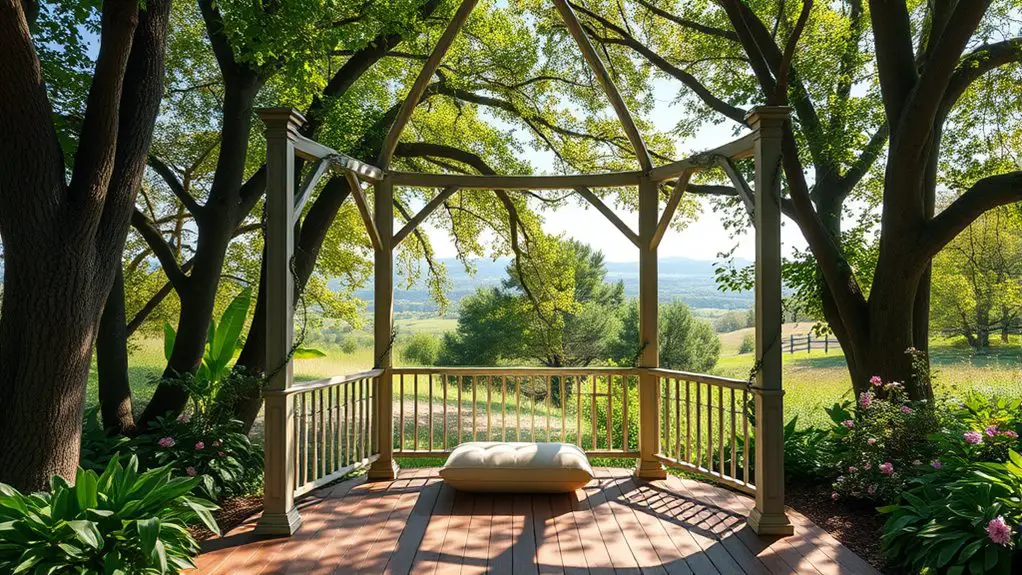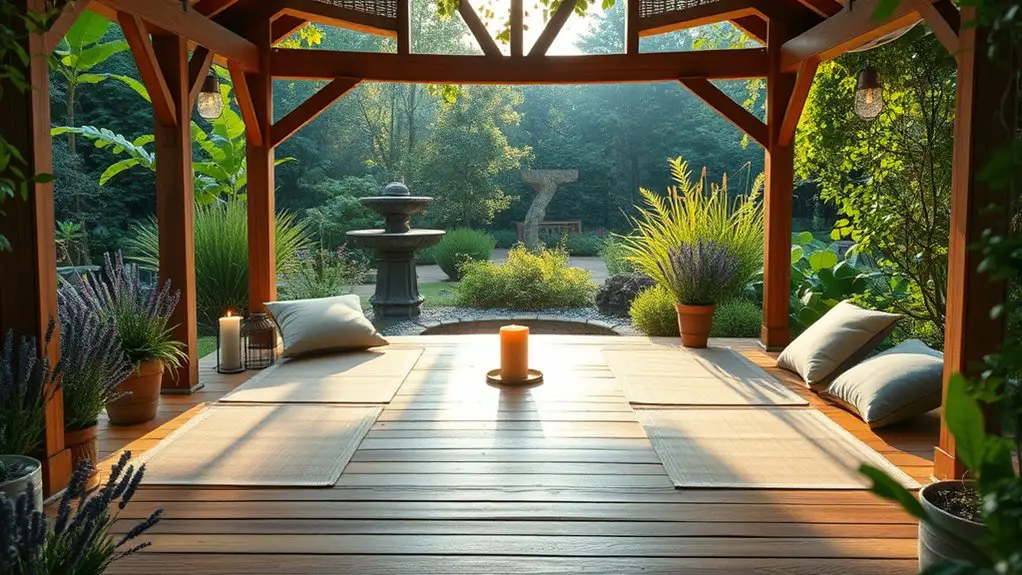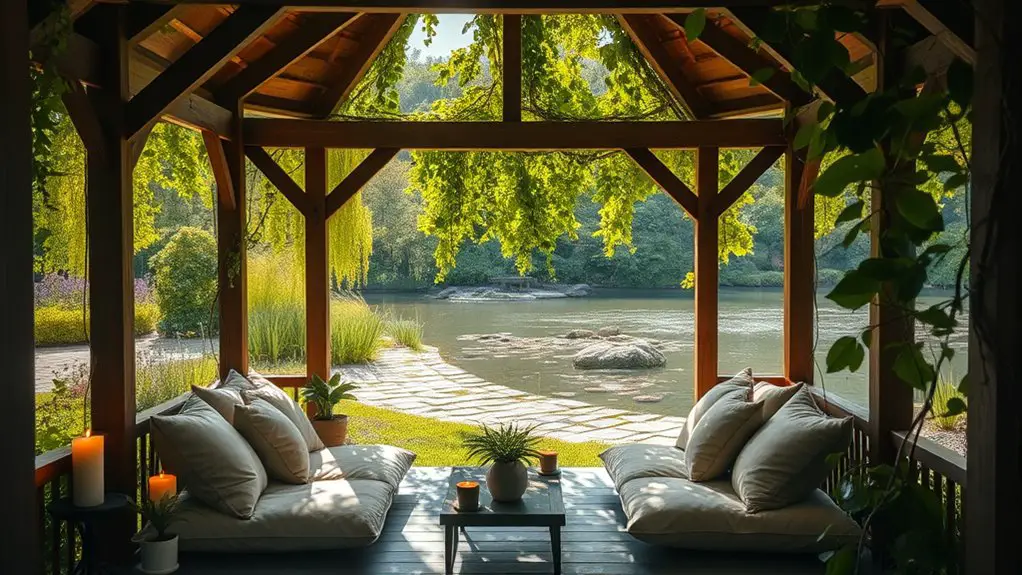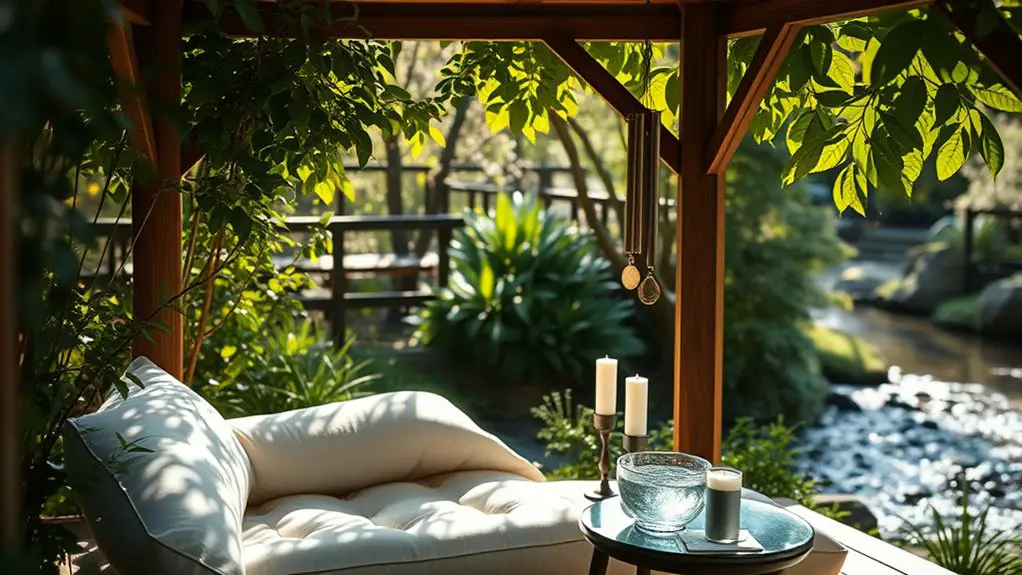To create the perfect gazebo meditation space, start by selecting a location that balances sunlight and shade while guaranteeing a flat, sturdy foundation. Design a calming atmosphere with soft colors and natural elements like plants. Incorporate essential meditation tools for comfort and mindfulness techniques to enhance your practice. Surround your gazebo with lush greenery, and maintain it regularly to guarantee tranquility. By following these guidelines, you’ll access the full potential of your sanctuary and elevate your meditation experience.
Choosing the Right Location for Your Gazebo

When choosing the right location for your gazebo, consider at least three key factors: sunlight, privacy, and accessibility. First, evaluate sunlight exposure; you want a balance of shade and warmth to create a comfortable meditation space. Positioning your gazebo to catch the morning sun can invigorate your practice, while afternoon shade provides relief during hotter days. Additionally, ensure the gazebo is placed on flat, sturdy ground to enhance stability and comfort during your meditation sessions.
Next, think about privacy considerations. Select a site that feels secluded, away from busy areas, to guarantee a tranquil atmosphere. Dense foliage or strategic landscaping can create a natural barrier, enhancing your sense of freedom and connection to nature.
Lastly, accessibility is essential. You’ll want a location that’s easy to reach but not too intrusive. A path leading to your gazebo should invite you in, while maintaining a sense of retreat. By thoughtfully addressing site selection, you’ll cultivate a personal sanctuary that invites peace and mindfulness.
Designing a Calming Atmosphere
Once you’ve chosen the perfect location for your gazebo, the next step is designing a calming atmosphere that enhances your meditation experience. Start with a harmonious color palette; soft blues, muted greens, and gentle earth tones can evoke tranquility. Consider painting the gazebo or adding cushions and throws in these shades to create a serene visual environment.
Incorporate sound elements to deepen your relaxation. You might install a small water feature, like a fountain, to provide soothing background sounds. Alternatively, consider wind chimes or soft instrumental music that can play gently in the breeze.
Ensure the space is clutter-free, allowing your mind to rest. You might also add natural elements, such as plants or stones, that resonate with you, enhancing the overall ambiance. Additionally, incorporating natural elements like plants can enrich your meditation experience and promote tranquility. By carefully curating these aspects, you’ll create a perfect sanctuary for meditation, where peace and freedom can flourish.
Essential Elements for Meditation

While cultivating a peaceful meditation practice, incorporating vital elements can greatly enhance your experience. Start by choosing the right meditation tools; cushions or mats can provide comfort, allowing you to focus on your breath rather than physical discomfort. Consider using a timer or a meditation app to track your sessions, helping you stay committed.
Integrating mindfulness techniques is equally important. Visualization can deepen your practice, allowing you to create a mental sanctuary. Additionally, sound can play a significant role—using singing bowls or calming music can help center your thoughts and elevate your mood.
Don’t overlook lighting; soft, adjustable illumination can foster a serene atmosphere conducive to meditation. Finally, keep your space clutter-free to minimize distractions, promoting a clear mind. By thoughtfully selecting these vital elements, you’ll create a meditation environment that supports your journey towards inner peace and freedom.
Incorporating Nature Into Your Space
Creating a serene meditation space goes beyond just selecting the right tools and techniques; integrating elements of nature can greatly enhance your practice. Start by choosing plants that resonate with you—consider low-maintenance options like succulents or ferns, which not only purify the air but also bring a rejuvenating green vibe. Position them around your gazebo to create a lush sanctuary.
Incorporate nature sounds into your meditation sessions. You might use a Bluetooth speaker to play ambient sounds like rustling leaves, flowing water, or chirping birds. These auditory elements can deepen your relaxation and help you connect with the environment.
Lastly, consider the layout—arranging plants to frame your meditation area can create a natural cocoon, fostering a sense of peace and freedom. By thoughtfully selecting plants and incorporating soothing sounds, you’ll cultivate a vibrant, nature-infused meditation space that truly enhances your experience.
Maintaining Your Gazebo Meditation Sanctuary

To guarantee your gazebo meditation sanctuary remains a peaceful retreat, you’ll need to incorporate regular maintenance into your routine. Start with gazebo upkeep by inspecting the structure for any signs of wear. Check for loose boards and rusty nails, addressing these issues promptly to maintain safety and aesthetics.
Seasonal care plays an essential role too. In spring, wash the surfaces and apply a protective sealant to prevent moisture damage. Summer’s heat may require you to trim nearby foliage, keeping your space open and airy. As autumn approaches, clear fallen leaves and debris to maintain cleanliness. Winter demands special attention; make sure snow doesn’t accumulate on the roof, as excess weight can cause damage. Additionally, be sure to check for water damage and address any mold or rotting wood promptly to ensure a safe and inviting environment.
Finally, regularly wash your cushions and decor, preserving the inviting atmosphere. By committing to consistent maintenance, you’ll cultivate a serene environment that invites you to unwind and reconnect with nature whenever you seek refuge.
Frequently Asked Questions
What Materials Are Best for Building a Gazebo Meditation Space?
When choosing materials for your gazebo, focus on quality wood selection for the framework, ensuring it’s resistant to weather. Pair this with durable roofing to protect your serene space from the elements, enhancing your meditation experience.
How Do I Choose the Right Size for My Gazebo?
When picking gazebo dimensions, think of a grand oasis! Consider your space planning needs—do you want a cozy nook or a spacious retreat? Balance aesthetics and functionality to create your ultimate sanctuary.
Can I Use My Gazebo for Other Activities Besides Meditation?
Absolutely, you can use your gazebo for yoga sessions or outdoor reading. Its serene environment enhances focus and relaxation, allowing you to explore various activities while enjoying the freedom and tranquility of nature.
What Time of Day Is Best for Meditation in My Gazebo?
The best time for meditation in your gazebo is during the morning calm or evening serenity. Both periods offer unique tranquility, enhancing your experience and allowing deeper connection with nature and inner peace. Enjoy the freedom of choice!
How Can I Ensure Privacy in My Gazebo Meditation Space?
To transform your gazebo into an impenetrable fortress of tranquility, explore fencing options like bamboo or trellis, and add sound barriers such as water features or dense plants to create a serene, private meditation haven.

